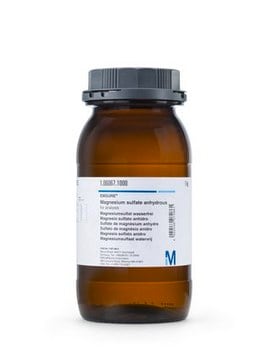M7506
Magnesium sulfate
anhydrous, ReagentPlus®, ≥99.5%
About This Item
Recommended Products
grade
anhydrous
Agency
suitable for SM 5210
vapor density
<0.01 (vs air)
vapor pressure
<0.1 mmHg ( 20 °C)
product line
ReagentPlus®
Assay
≥99.5%
form
powder
pH
~7.9 (25 °C, 50 g/L)
SMILES string
[Mg++].[O-]S([O-])(=O)=O
InChI
1S/Mg.H2O4S/c;1-5(2,3)4/h;(H2,1,2,3,4)/q+2;/p-2
InChI key
CSNNHWWHGAXBCP-UHFFFAOYSA-L
Looking for similar products? Visit Product Comparison Guide
General description
Application
- In Biginelli reactions to synthesize dihydropyrimidinones by solvent-free conditions.
- In the synthesis of 2-imidazolines by the reaction of aldehydes and ethylenediamine in the presence of hydrogen peroxide and sodium iodide.
The mixture of MgSO4 and bayerite is used to prepare single-phase,MgAl2O4 spinel nanoparticles by calcining the powder mixture at 800 oC.
MgSO4 (anhydrous) can also be used as a drying agent in organic synthesis for the removal of traces of water from organic extracts.
Other Notes
Legal Information
reagent
Storage Class Code
13 - Non Combustible Solids
WGK
WGK 1
Flash Point(F)
Not applicable
Flash Point(C)
Not applicable
Regulatory Listings
Regulatory Listings are mainly provided for chemical products. Only limited information can be provided here for non-chemical products. No entry means none of the components are listed. It is the user’s obligation to ensure the safe and legal use of the product.
JAN Code
2540099:
M7506-12KG-PW:
M7506-BULK:
M7506-2KG-PW:
M7506-25KG:
M7506-12KG:4548173203454
M7506-500G:4548173203478
QR-018-1KG:
M7506-1KG-PW:
M7506-VAR-D:
M7506-2KG:
M7506-1KG:4548173203461
M7506-25KG-PW:
M7506-VAR:
M7506-500G-PW:
M7506-36X500G:
Certificates of Analysis (COA)
Search for Certificates of Analysis (COA) by entering the products Lot/Batch Number. Lot and Batch Numbers can be found on a product’s label following the words ‘Lot’ or ‘Batch’.
Already Own This Product?
Find documentation for the products that you have recently purchased in the Document Library.
Customers Also Viewed
Articles
JosiPhos CyPF-tBu and palladium give catalyst for alkoxylation of activated heteroaryl halides with primary, secondary, and tertiary alcohols
Chromatograms
suitable for GC/MSOur team of scientists has experience in all areas of research including Life Science, Material Science, Chemical Synthesis, Chromatography, Analytical and many others.
Contact Technical Service










